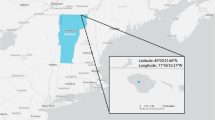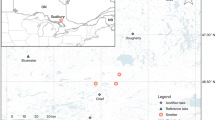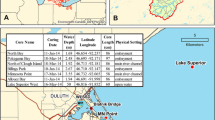Abstract
Farmington Bay (FB), UT, has undergone major water quality changes due to human interventions. An arm of the Great Salt Lake (GSL), FB, is an endorheic body, actively accumulating nutrients. Human impacts to FB began in 1847 when European settlers arrived and major ecosystem changes have resulted through local development. Major impacts include anthropogenically impacted discharges (AID), causeway construction, and water-level declines. AID includes raw and treated sewage, septic leachate, irrigation returns, and feedlot or pasture runoff. Causeway construction produced freshening (hypersaline to fresh-brackish) via hydrodynamic isolation, whereas diversions and a drying climate prevent AID from mixing with the rest of the GSL. The timing of human interventions is known, allowing identification of ecosystem response in three sediment cores analyzed for 210Pb chronology, mineralogy, C and N isotopes, pyrolysis, porewater chemistry, and diatom stratigraphy. From these proxies, three events have profoundly altered FB. A sewage canal (1911) brought raw effluent from Salt Lake City, causing a rise in the d15N of organic matter (OM). A corresponding increase in carbonate production occurred as enhanced productivity led to higher pH. Causeway construction (1969) spurred algal growth as FB freshened. Declining water levels (> 1990) resulted in a shrinking volume of bay water, resulting in increased eutrophication. P is elevated in porewater due to OM decay. ~ 0.9 gm−2 year−1 phosphate is released to the water column, compared to an estimated 3.0 gm−2 year−1 surface inflow loading. Although ecosystem improvements may result from AID reductions, improvements in water quality are most easily achieved by restoring surface inflows to FB.










Similar content being viewed by others
Data Availability
The datasets generated during and/or analyzed during the current study are available from the corresponding author on reasonable request. However, some files (X-ray diffraction) may require the use of proprietary software in order to display and reduce data. Production of this study was enabled commonly available computer codes, except for Rietveld refinements of mineral abundances employing Rigaku PDXL2 software. The Central Davis and South Davis Wastewater Districts also provided important logistical support.
References
Allen, E. D., & Spence, D. H. N. (1981). The differential ability of aquatic plants to utilize the inorganic carbon supply in fresh waters. New Phytologist, 87, 269–283.
Antonielli, M., Pasqualini, S., Batini, P., Ederli, L., Massacci, A., & Loreto, F. (2002). Physiological and anatomical egreealzation of Phragmites australis leaves. Aquatic Botany, 72, 55–66. https://doi.org/10.1016/S0304-3770(01)00220-0
Appleby, P.G. (2001). Chronostratigraphic Techniques in Recent Sediments, in Last, W.M. and Smol, J.P. eds., Tracking environmental change using lake sediments: Basin analysis, coring, and chronological techniques, Dordrecht, Springer Netherlands, Developments in Paleoenvironmental Research, 171–203.
Baskin, D. K. (1997). Atomic H/C ratio of kerogen as an estimate of thermal maturity and organic matter conversion. American Association of Petroleum Geologists Bulletin, 81, 1437–1450. https://doi.org/10.1306/3B05BB14-172A-11D7-8645000102C1865D
Bateman, A. S., Kelly, S. D., & Jickells, T. D. (2005). Nitrogen isotope relationships between crops and fertilizer: Implications for using nitrogen isotope analysis as an indicator of agricultural regime. JOurnal of Agricultural and Food Chemistry, 53, 5760–5765. https://doi.org/10.1021/jf050374h
Behar, F., Beaumont, V., & Penteado, H. D. B. (2001). RockEval 6 technology: Performances and developments. Oil and Gas Science and Technology, 56, 111–134.
Bhagowati, B., & Ahamad, K. U. (2019). A review on lake eutrophication dynamics and recent developments in lake modeling. Ecohydrology & Hydrobiology, 19(1), 155–166. https://doi.org/10.1016/j.ecohyd.2018.03.002
Carlson, R. E. (1977). A trophic state index for lakes. Limnology and Oceanography, 22, 361–369.
Clark, I. D., & Fritz, P. (1997). Environmental isotopes in hydrogeology (p. 342). FL, CRC Press.
Clavero, E., Hernández-Mariné, M., Grimalt, J. O., & Garcia-Pichel, F. (2000). Salinity tolerance of diatoms from thalassic hypersaline environments. Journal of Phycology, 36, 1021–1034. https://doi.org/10.1046/j.1529-8817.2000.99177.x
Coburn, A. A. and Eckhoff, D.W. (1972). Pollution input from the Lower Jordan Basin to Antelope Island Estuary. Pages 104‐120 in J. P. Riley, editor. The Great Salt Lake and Utah’s water resources. Proceedings of the first annual conference of the Utah Section of the American Water Resource Association. Utah Water Research Laboratory. Utah State University, p. 104–120.
Correll, D. L. (1998). The role of phosphorus in the eutrophication of receiving waters: A review. Journal of Environmental Quality, 27(2), 261–266. https://doi.org/10.2134/jeq1998.00472425002700020004x
Delwiche, C. C., & Steyn, P. L. (1970). Nitrogen isotope fractionation in soils and microbial reactions. Environmental Science & Technology, 4, 929–935.
Dembicki, H., Jr. (2009). Three common source rock evaluation errors made by geologists during prospect or play appraisals. AAPG Bulletin, 93, 341–356. https://doi.org/10.1306/10230808076
Eakins, J. D., & Morrison, R. T. (1978). A new procedure for the determination of lead-210 in lake and marine sediments. International Journal of Applied Radioactive Isotopes, 29, 531–536.
Espitalie, J., Deroo, J., & Marquis, F. (1985). Rock-eval pyrolysis and its application. Revue De L’institut Francais Du Petrole, 40, 318–329.
Espitalie, J.,Laporte, J.L., Madec, M., Marquis, F., Leplat, P., Paulet, J. & Boutefeu, A. (1977). Methode rapide de caracterisation des roches metres, de leur egreeal petrolier et de leur egree d’evolution. Revue de l’Institut franc_ais du Petrole 32, 23–42.
Fetter, C. W., Boving, T. B., & Kreamer, D. K. (1999). Contaminant hydrogeology. Prentice Hall.
Fisher, M. M., & Reddy, K. R. (2013). Soil pore water sampling methods. Methods in Biogeochemistry of Wetlands, 10, 55–70.
Fyfe, W.S., and Bischoff, J.L. (1965). The calcite-aragonite problem. In Dolomitization and Limestone Diagenesis—A Symposium. Society of Economic Paleontologists and Mineralogists Special Publication, 3–13.
Goel, R., and Myers, L. (2009). Evaluation of cyanotoxins in the Farmington Bay, Great Salt Lake, Utah: University of Utah Report, 38 p. https://pdfs.semanticscholar.org/78ed/e9c2566ad296295c7edfbab1060d298faadd.pdf. Accessed 28 Jul 2021.
Gulati, R.D. and Van Donk, E. (2002). Lakes in the Netherlands, their origin, eutrophication and restoration: state-of-the-art review. In Ecological Restoration of Aquatic and Semi-Aquatic Ecosystems in the Netherlands (NW Europe) (pp. 73–106). Springer, Dordrecht.
Gunnell, N.V., (2020). A study of the anthropogenic impact in Farmington Bay through isotopic and elemental analysis, MS Thesis, Brigham Young University, 77 p, available at: https://scholarsarchive.byu.edu/etd/9208/
Hamilton, S. K., Bruesewitz, D. A., Horst, G. P., Weed, D. B., & Sarnelle, O. (2009). Biogenic calcite–phosphorus precipitation as a negative feedback to lake eutrophication. Canadian Journal of Fisheries and Aquatic Sciences, 66, 343–350.
Hart, R., Nelson, S. T., & Eggett, D. (2010). Uncertainty in 14C model ages of saturated zone waters: The influence of soil gas in terranes dominated by C3 plants. Journal of Hydrology, 392, 83–95. https://doi.org/10.1016/j.jhydrol.2010.08.001
Hilsenhoff, W. L. (1987). An improved biotic index of organic stream pollution. The Great Lakes Entomologist, 20, 31–39.
Hofmann G, Werum M, Lange-Bertalot H. (2013). Diatomeen im Ssußwasser-Benthos von Mitteleuropa. Bestimmungsflora Kieselalgen für die Ökologische Praxis. 2. korrigierte Auflage 2013. Königstein: (Gantner) ARG Ruggell.
Hudson, S. M., Hillam, S., Barker, J., Nelson, S., & Rey, K. (2019). Pyrolysis of modern wetland sediment: Extracting climate records from fens in the Uinta Mountains and Fish Lake Plateau, Utah, USA. Boreas, 48, 810–824. https://doi.org/10.1111/bor.12378
Jeppesen, E., Moss, B., Bennion, H., Carvalho, L., DeMeester, L., Feuchtmayr, H., Friberg, N., Gessner, M.O., Hefting, M., Lauridsen, T.L. and Liboriussen, L. (2010). Interaction of climate change and eutrophication. Climate Change Impacts on Freshwater Ecosystems, 119–151.
Keller, K., & Morel, F. M. (1999). A model of carbon isotopic fractionation and active carbon uptake in phytoplankton. Marine Ecology Progress Series, 182, 295–298. https://doi.org/10.3354/meps182295
Krammer K, Lange-Bertalot H. (1986). Bacillariophyceae. 1. Teil: Naviculaceae. In Süsswasserflora von Mitteleuropa Vol. 2/1, Ettl H, Gerloff J, Heynig H, Mollenhauer D (eds). Gustav Fischer Verlag: Stuttgart, 1–876.
Krammer K, Lange-Bertalot H. (1988). Bacillariophyceae. 2. Teil: Bacillariaceae, Epithemiaceae, Surirellaceae. In Süsswasserflora von Mitteleuropa Vol. 2/2, Ettl H, Gerloff J, Heynig H, Mollenhauer D (eds). Gustav Fischer Verlag: Jena, 1–610.
Krammer K, Lange-Bertalot H. (1991a). Bacillariophyceae. 3. Teil: Centrales, Fragilariaceae, Eunotiaceae. In Süsswasserflora von Mitteleuropa Vol. 2/3, Ettl H, Gerloff J, Heynig H, Mollenhauer D (eds). Gustav Fischer Verlag: Stuttgart, 1–576.
Krammer K, Lange-Bertalot H. (1991b). Bacillariophyceae. 4. Teil: Achnanthaceae, Kritische Erg€anzungen zu Navicula (Lineolatae) und Gomphonema, Gesamtliteraturverzeichnis Teil 1–4. In Süsswasserflora von Mitteleuropa Vol. 2/4, Ettl H, Gärtner G, Gerloff J, Heynig H, Mollenhauer D (eds). Gustav Fischer Verlag: Stuttgart, 1–437.
Lafargue, E., Marquis, F., & Pillot, D. (1998). Rock-Eval 6 applications in hydrocarbon exploration, production, and soil contamination studies. Revue De L’institut Francais Du Petrole, 53, 421–437.
Lange-Bertalot, H., Hofmann, G., Werum, M., Cantonati, M., & Kelly, M. G. (2017). Freshwater benthic diatoms of Central Europe: Over 800 common species used in ecological assessment (Vol. 942). Koeltz Botanical Books.
Lapointe, B. E., Herren, L. W., Debortoli, D. D., & Vogel, M. A. (2015). Evidence of sewage-driven eutrophication and harmful algal blooms in Florida’s Indian River Lagoon. Harmful Algae, 43, 82–102. https://doi.org/10.1016/j.hal.2015.01.004
Leavitt, P.R., Bunting, L., Moser, K., and Woodward, C. (2012). Effects of wastewater influx and hydrologic modification on algal production in the Great Salt Lake of Utah, USA. UQ eSpace: University of Regina, University of Western Ontario, https://espace.library.uq.edu.au/view/UQ:341860, accessed Mar 2019.
Li, Y. H., & Gregory, S. (1974). Diffusion of ions in sea water and in deep-sea sediments. Geochimica Et Cosmochimica Acta, 38, 703–714.
Liu, X., Bo, Y., Zhang, J., & He, Y. (2015). Classification of C3 and C4 vegetation types using MODIS and ETM+ blended high spatio-temporal resolution data. Remote Sensing, 7(11), 15244–15268. https://doi.org/10.3390/rs71115244
Marty, J., & Planas, D. (2008). Comparison of methods to determine algal δ13C in freshwater. Limnology and Oceanography: Methods, 6, 51–63. https://doi.org/10.4319/lom.2008.6.51
Moser, K., Woodward, C., Leavitt, P.R., and Wurtsbaugh, W.A. (2012). Historical changes in aquatic invertebrates and charophytes of the Great Salt Lake, Utah (USA): The effects of wastewater inputs, water diversions and barriers. University of Western Ontario, 27.
Naftz, D., Angeroth, C., Kenney, T., Waddell, B., Darnall, N., Silva, S., Perschon, C., & Whitehead, J. (2008). Anthropogenic influences on the input and biogeochemical cycling of nutrients and mercury in Great Salt Lake, Utah, USA. Applied Geochemistry, 23(6), 1731–1744. https://doi.org/10.1016/j.apgeochem.2008.03.002
Naftz, D.L., Stephens, D.W., Callender, E., and Van Metre, P.C. (2000). Reconstructing historical changes in the environmental health of watersheds by using sediment cores from lakes and reservoirs in Salt Lake Valley, Utah. US Geological Survey Fact Sheet FS-164–00.
Nazari-Sharabian, M., Ahmad, S., & Karakouzian, M. (2018). Climate change and eutrophication: A short review. Engineering, Technology and Applied Science Research, 8(6), 3668.
Nelson, S. T., & Rey, K. A. (2018). Multi-proxy reassessment of the paleolimnology of Lake Bonneville (western USA) as observed in the restricted Pilot Valley sub-basin. Journal of Quaternary Science, 33, 177–193. https://doi.org/10.1002/jqs.3014
NWIS (USGS National Water Information System) (2020). https://maps.waterdata.usgs.gov/mapper/, accessed 13 Nov. 2020.
NWIS (USGS National Water Information System) (2021). https://maps.waterdata.usgs.gov/mapper/, sites 410153112082301 and 410224112095101, accessed 27 Dec. 2021.
Ogino, T., Suzuki, T., & Sawada, K. (1987). The formation and transformation mechanism of calcium carbonate in water. Geochimica Et Cosmochimica Acta, 51, 2757–2767.
Paruelo, J. M., & Lauenroth, W. K. (1996). Relative abundance of plant functional types in grasslands and shrublands of North America. Ecological Applications, 6, 1212–1224.
Patrick RM, Reimer CW. (1966). The diatoms of the United States exclusive of Alaska and Hawaii, 1. Monographs of the Academy of Natural Sciences of Philadelphia 13.
Patrick RM, Reimer CW. (1975). The diatoms of the United States, exclusive of Alaska and Hawaii, 2. Monographs of the Academy of Natural Sciences of Philadelphia 13.
Peters, K. E. (1986). Guidelines for evaluating petroleum source rock using programmed pyrolysis. American Association of Petroleum Geologists Bulletin, 70, 318–329.
POPUS (Population.us) (2021). https://population.us/county, accessed 28 Dec. 2021.
Rogers, K. M. (2003). Stable carbon and nitrogen isotope signatures indicate recovery of marine biota from sewage pollution at Moa Point, New Zealand. Marine Pollution Bulletin, 46, 821–827. https://doi.org/10.1016/S0025-326X(03)00097-3
Saltonstall, K., Burdick, D., Miller, S. and Smith, B. (2005). Native and introduced Phragmites: challenges in identification, research, and management of the common reed. National Estuarine Research Reserve Technical Report Series, 40 p.
Schindler, D. W. (2012). The dilemma of controlling cultural eutrophication of lakes. Proceedings of the Royal Society b: Biological Sciences, 279(1746), 4322–4333. https://doi.org/10.1098/rspb.2012.1032
Schindler, D. W., Carpenter, S. R., Chapra, S. C., Hecky, R. E., & Orihel, D. M. (2016). Reducing phosphorus to curb lake eutrophication is a success. Environmental Science and Technology, 50, 8923–8929. https://doi.org/10.1021/acs.est.6b02204
Spaulding, S.A., Bishop, I.W., Edlund, M.B., Lee, S., Furey, P., Jovanovska, E. and Potapova, M. (2020). Diatoms of North America. https://diatoms.org/, accessed repeatedly.
Stowe, L. G., & Teeri, J. A. (1978). The geographic distribution of C4 species of the Dicotyledonae in relation to climate. The American Naturalist, 112, 609–623.
Takahashi, K., Yoshioka, T., Wada, E., & Sakamoto, M. (1990). Temporal variations in carbon isotope ratio of phytoplankton in a eutrophic lake. Journal of Plankton Research, 12, 799–808.
Tortell, P. D., Reinfelder, J. R., & Morel, F. M. (1997). Active uptake of bicarbonate by diatoms. Nature, 390, 243–244.
UGS (Utah Geological Survey) (2020). https://geodata.geology.utah.gov/imagery/ , accessed 27 Nov. 2020.
Urban, N. R., Dinkel, C., & Wehrli, B. (1997). Solute transfer across the sediment surface of a eutrophic lake: I. Porewater profiles from dialysis samplers. Aquatic Sciences, 59, 1–25.
US Census (2020a). https://www.census.gov/quickfacts/saltlakecountyutah, accessed 17 Aug., 2020.
US Census (2020b). https://www.census.gov/quickfacts/daviscountyutah, accessed 17 Aug., 2020.
US Census (2020c). https://www.census.gov/quickfacts/utahcountyutah, accessed 17 Aug., 2020.
USGS (United States Geological Survey) (2021). https://www.usgs.gov/news/great-salt-lake-reaches-new-historic-low, accessed 8 Sept, 2021.
Utah DEQ (Dept. of Environmental Quality) (2016a). https://deq.utah.gov/water-quality/farmington-bay-algal-bloom-2016, accessed 17 Aug, 2020.
Utah DEQ (Dept. of Environmental Quality) (2016b). https://deq.utah.gov/legacy/programs/water-quality/monitoring-reporting/assessment/docs/2016/chapter-6-farmingtonbay-final2016ir-v2-1.pdf, accessed 17 Aug., 2020.
van Dam, H., Mertens, A., & Sinkeldam, J. (1994). A coded checklist and ecological indicator values of freshwater diatoms from the Netherlands. Netherlands Journal of Aquatic Ecology, 28, 117–133.
Verardo, D. J., Froelich, P. N., & McIntyre, A. (1990). Determination of organic carbon and nitrogen in marine sediments using the Carlo Erba NA-1500 analyzer. Deep Sea Research Part A. Oceanographic Research Papers, 37, 157–165.
Vinçon-Leite, B., & Casenave, C. (2019). Modelling eutrophication in lake ecosystems: A review. Science of the Total Environment, 651, 2985–3001. https://doi.org/10.1016/j.scitotenv.2018.09.320
Wada, E., Kadonaga, T., & Matsuo, S. (1975). 15N abundance in nitrogen of naturally occurring substances and global assessment of denitrification from isotopic viewpoint. Geochemical Journal, 9, 139–148. https://doi.org/10.2343/geochemj.9.139
Witkowski A, Lange-Bertalot H, Metzeltin D. (2000). Diatom flora of marine coasts. In Iconographica Diatomologica 7, Lange-Bertalot H, ed. A. R. G. Gantner Verlag K. G.: Ruggell.
Wurtsbaugh, W., and Marcarelli, A., Christison, C., Moore, J., Gross, D., Bates, S., and Kircher, S. (2002). Comparative analysis of pollution in Farmington Bay and the Great Salt Lake, Utah. Report to the Utah Division of Water Quality, 21 p.
Wurtsbaugh, W., and Marcarelli, A. (2006). Eutrophication in Farmington Bay, Great Salt Lake, Utah 2005 Annual Report.Utah State University, https://digitalcommons.usu.edu/cgi/viewcontent.cgi?article=1559&context=wats_facpub. Accessed 18 Nov 2020.
Wurtsbaugh, W., Macarelli, A., and Boyer, G., (2012). Eutrophication and metal concentrations in three bays of the Great Salt Lake (USA). Final Report to the Utah Division of Water Quality, 70 p.
Xu, J., Zhang, M., & Xie, P. (2007). Stable carbon isotope variations in surface bloom scum and subsurface seston among shallow eutrophic lakes. Harmful Algae, 6, 679–685. https://doi.org/10.1016/j.hal.2007.02.002
Funding
This study was funded by the Wasatch Front Water Quality Council, of which co-authors Leland Myers and Theron Miller are members.
Author information
Authors and Affiliations
Corresponding author
Ethics declarations
Conflict of Interest
The authors declare no competing interests.
Additional information
Publisher's Note
Springer Nature remains neutral with regard to jurisdictional claims in published maps and institutional affiliations.
Rights and permissions
About this article
Cite this article
Gunnell, N., Nelson, S., Rushforth, S. et al. From Hypersaline to Fresh-Brackish: Documenting the Impacts of Human Intervention on a Natural Water Body from Cores, Farmington Bay, UT, USA. Water Air Soil Pollut 233, 35 (2022). https://doi.org/10.1007/s11270-022-05507-x
Received:
Accepted:
Published:
DOI: https://doi.org/10.1007/s11270-022-05507-x




